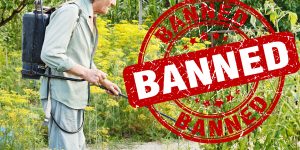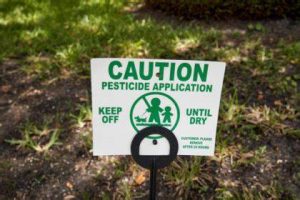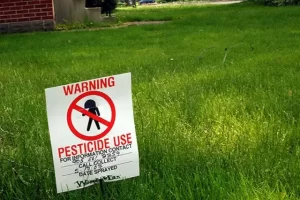


Environmental Impact of Pesticides
Pesticides can travel far from where they were originally applied. They drift in the wind when sprayed in gardens or can run off into streams and rivers when washed away by rainfall. In some cases the pesticides will remain there for years and go from one organism to another.
Selective pesticides are only dangerous to their targeted pests however non-selective pesticides are harmful to many organisms which are beneficial to the ecosystem. People who handle pesticides have to be careful with their application in order to reduce their damage to the surrounding environment. Incorrect use of pesticides leads to:
- Disruptions in the local ecosystem
- Long-term damage to soils and water sources
- Death or injury to non-targeted organisms
- Superbugs which grow resistant to the pesticide
Insecticides tend to be the class of pesticides that are the most harmful to the environment, followed closely by fungicides and herbicides. Their effect on the ecosystem depends on whether they are fat soluble or water soluble.
Water soluble pesticides seep into surrounding environment when they are carried along by stormwater. Fat soluble pesticides are carried along by animals which results in high levels of toxicity in the food chain.
Toxic Food Chains
Fat soluble pesticides such as DDT accumulate in the food chain and wreak havoc to every animal on it. The animals at the top of the food chain are likely to suffer from higher levels of toxicity due to a phenomenon known as bioaccumulation. Small levels of the pesticide will be found in insects such as grasshoppers which will be eaten by mice and shrews. The owl then eats the shrews and gains a level of toxicity that is equal to the sum of the toxicity levels of all of the animals at the bottom of the food chain.
The owls die off first thanks to bioaccumulation. The next animal down the food chain then enjoys a surge in numbers thanks to the low population of its natural predator and then decreases the population of the animal at the bottom.
Environmental Disaster: Continue reading here Environment – SEPA – Safe and Effective Pesticide Applications – NCRR SEPA
Pesticides can affect the environment in several ways. They can contaminate soil, water, turf, and other vegetation1. Pesticides can also be toxic to non-target organisms such as birds, fish, beneficial insects, and non-target plants2. Additionally, pesticides can pollute air, water, and soil2. Pesticides can change the chemical properties of the soil, making it inhospitable to future crops2. Pesticides have been linked to the worldwide decline of honeybee colonies2. I hope this helps.
Human Health Issues Related to Pesticides
Pesticides are designed to (in most cases) kill pests. Many pesticides can also pose risks to people. Generally, however, people are likely to be exposed to only very small amounts of a pesticides – too small to pose a risk.
To determine risk, one must consider both the toxicity or hazard of the pesticide and the likelihood of exposure. A low level of exposure to a very toxic pesticide may be no more dangerous than a high level of exposure to a relatively low toxicity pesticide, for example.
On this page:
- What are the potential health effects of pesticides?
- How does EPA determine what the effects of pesticides on humans are and whether they are acceptable?
- Where can I get information on health risks of pesticides I have in my home?
- How does EPA use information on toxicity and health effects of pesticides?
- What other information is there?
Lawn Pesticides and Pets
The evidence continues to mount that lawn pesticides are harmful to pets (as well as humans and wildlife). From weed killers to toxic insecticides, it all plays a role in making your dog sick. Dogs tend to be the pets that come into contact the most with harmful lawn pesticides, but other outdoor-loving pets are just as susceptible to negative health outcomes. Whether it’s a scientific study or an anecdote from a pet owner, all of the evidence tells us that lawn pesticides and pets shouldn’t mix. There’s a lot of information out there about the impacts of lawn pesticides on pets, so we’ve put it all together right here for you. Let’s dive into it!
Why Lawn Pesticides and Dogs Shouldn’t Mix
The evidence is clear — pesticides and pets aren’t a safe combination. Pesticides, including herbicides and insecticides, are scientifically proven to be harmful to pets’ health. Studies published in 2012 and 1991 found a significant link between lawn chemicals and cancer in dogs. In fact, dogs with malignant cancer were 70% more likely to be from
homes where owners used chemical insecticides. Both studies came to the conclusion that the use of conventional lawn care chemicals is likely to increase the risk of Canine malignant lymphoma.
A study published in 2013 showed that herbicides can be detected in a dog’s urine after lawn treatment, proving that the chemicals do in fact make their way into pets’ systems after they are used on the lawn. The appearance of these harmful chemicals in dogs’ urine explains why exposure to herbicide-treated lawns is known to be associated with higher bladder cancer risk in dogs.
If you have pets, it’s important to keep the toxicity of pesticides in mind when making a choice about lawn care. Pets are particularly susceptible to the harmful effects of lawn pesticides because they go onto the lawn multiple times a day to go to the bathroom. On top of that, most dogs spend hours laying, playing, and rolling on the lawn. Dogs are then directly exposed to the chemicals on the lawn, and can even ingest those chemicals by licking their skin or paws.
There are several alternatives to herbicides. Some of them include:
- Garden design
- Mulching
- Ground cover
- Crop rotation
- Good soil management
- Biological control
- Organic weedkillers
- Flame guns
- Sanitation
- Exclusion
- Prevention
- Hand weeding
- Use of cover crops
- Heat
- Natural acids (vinegar + citric acids)
- Herbicidal soaps
- Iron-based herbicides
- Salt-based herbicides
- Natural phytotoxic oils (clove oil, peppermint oil, pine oil, citronella oil)
- Corn gluten meal1.
I hope this helps. Let me know if you have any other questions.
ADDITIONAL RESOURCES:
Department of Agriculture | Contacts (nj.gov)
NJDEP-Compliance and Enforcement – Pesticide Regulations
New State Law (P.L. 2021, c.386) Restricting Neonicotinoid Pesticide Use (rutgers.edu)
